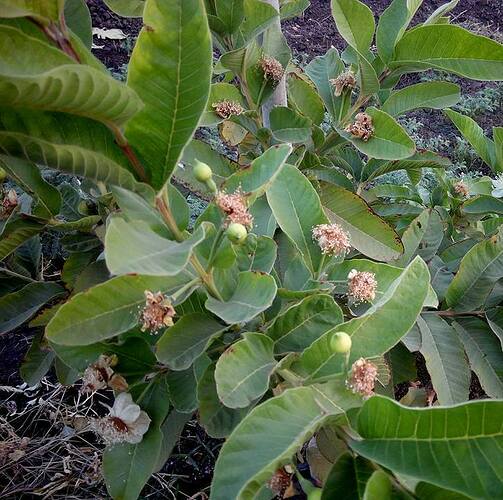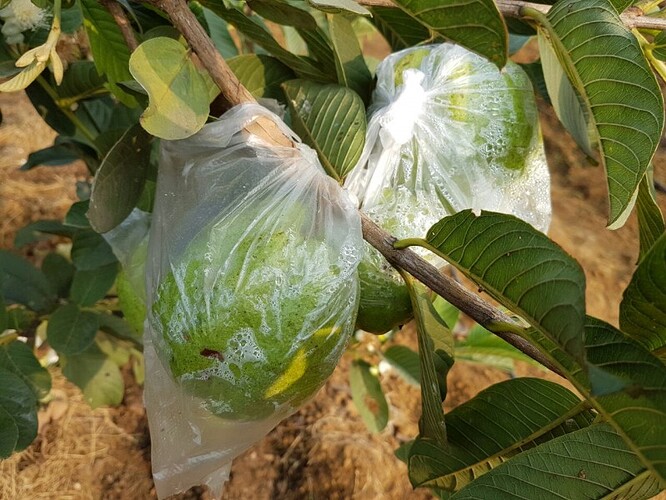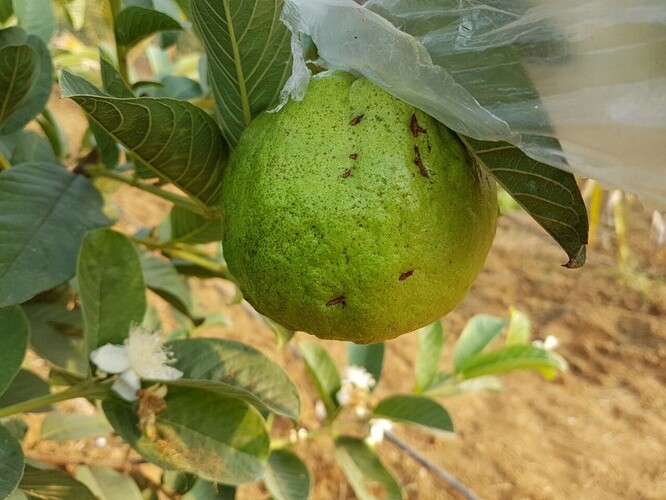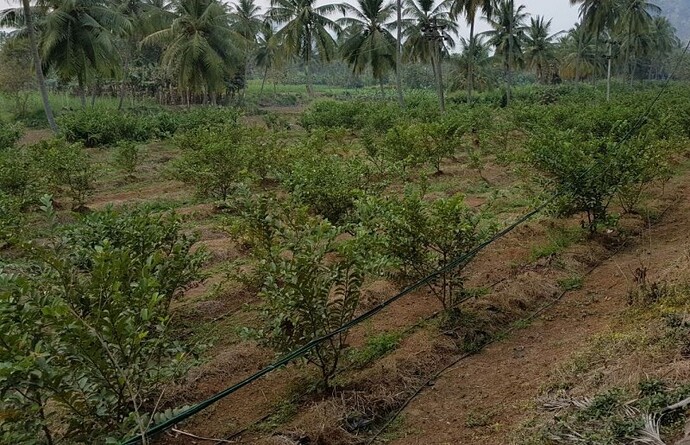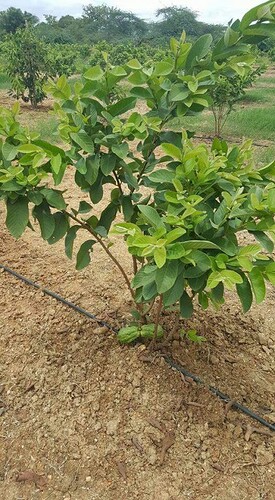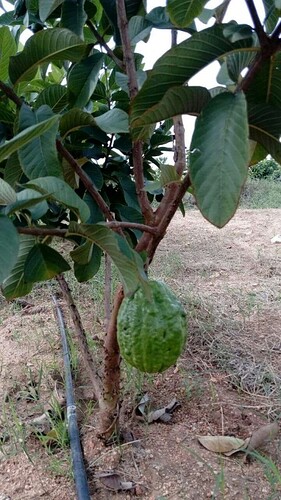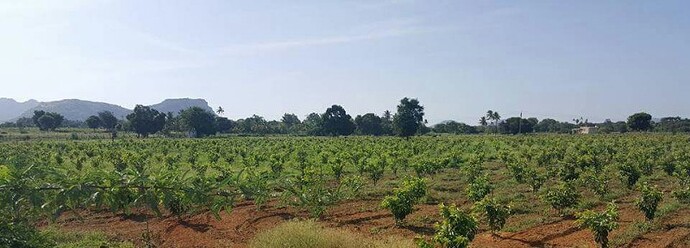Thaiwan guava is becoming popular every year among the guava farmers . The reason is regular fruiting character with two production season every year one from March to April and another from July August …
Another most important character of thaiwan guava is sweetiness of fruit . The high ascorbic acid content in the fruits makes this guava fruit internally acclaimed and most sought after fruit in the international market fetching premium price for quality fruits … Each fruit weighs around 250 -300 grams . The foreign buyers prefer this size to bigger size .And the fruit looks light green in maturity
The thaiwan guava tree reaches the height of 2.5 to 3.0 Meters in average with canopy size of 2.0 to 2.5 Meter diameter
Planting season – one month before onset of monsoon in India …June – July
Planting pits – The pits are dug in the dimension of 2’ * 2’ * 2” BLD a month before planting and allowed the pits to cure until planting is done . Before the planting , the top soil dug out of each pit is mixed with 10 kgs of farm yard manure , 100 grams urea, 100 grams potassium and 2.0 kgs of super phosphate and pit is filled upto 45 centimeters depth and thaiwan guava seedling is planted just in the centre of pit with graft union exposed from soil level inside the pit . The seeddlings must be planted 15-20 Cms down the general field surface inside the pit .
After the planting , the Bio fertilizers, bio pesticides and VAM fungal culture that are mixed together with powdered farmyard manure and neem cake are applied @ 250- 500 grams to each pit and watered …
Spacing of the plants – 3.0 Meter by 2.0 meter row to row and plant to plant spacing is adopted for high yield of thaiwan guava . At this spacing 666 plants are planted in an acre of land …
Mulching of guava trees – Mulching with coir pith waste provide excellent cover against hot sun and prevent weeds as well as water and nutrient loss thus enhance growth and fruits quality
Training and pruning of Thaiwan guava – When the plant reaches 75-80 cms high , cut back the plant to the height of 50-60 cms from the ground . This will stimulate the branching ( primary scaffold ) . when the side branch reaches 30-40 cms long growth , select 3 – 4 strong branches in such a way that the retained branches fan around the central stem like an umbrella and all other weak branches are removed . The retained branches are cut back to half the length say 20 cms long or just green immatured part of the branches are cut off retaining matured brown color twigs of each retained primary branches . And further branching is encouraged in each primary branches . The same procedure is applied here in pruning the secondary branches as done earlier in the primary branches and 2-3 secondary branches are allowed in each primary branches and thrid light pruning is done on each secondary branches to produce tertiary branches . This will shape thaiwan guava tree with excellent canopy that produce excellent flowers and fruits
Each tree has 3 primary branches and 2 secondary branches and 4 tertiary branches . So total no of branches in each tree is 3* 2 * 4 = 24 shoots that produce flowers
Each branch produce 3 fruits in ana average . so single plant produce 24 branches * 3 fruits = 72 fruits . Each fruit is weighing about average 250 grams per fruit
So total fruit weight per tree is 72 fruits * 0.250 kgs = 18 kgs
So 666 guava tree produces 666 plants * 18 kgs = 12.0 MT ( 11,988 kgs )
There are tow harvest . so annaul per acre yield of guava fruit is 24.0 MT
Each kg of thaiwan guava sells @ Rs. 50 in Indian market and Rs.150 in overseas market
So per acre income is 24,000 kgs * Rs.50 = 12.0 lacs in domestic markets
To obtain abov income following intervention is needed
As plant grows we need to increase soil organic carbon to the level of atleast 2.0 % ( higher level of productivity is obtained in soil carbon level of 4.0 to 5.0 % )
Indian soil except hilly region is having very poor level of organic carbon say around 0.5 % . At this level of soil organic carbon , the soil remains less productive or simply sterile and produce less yield and poor fruit quality .
So to increase soil organic carbon we need to apply green manure or green leaf manure . During monsoon season sow 8-10 kgs of sunhemp seeds in the interrow spaces . This will in about 50-55 days give 6-8 MT of green bio mass . The plants are harvested and laid close to plants in rows along the guava plants and covered by soil . And if possible we can spray Urea + gypsum mix over the green matter and then cover by soil . This will escalate decomposition process faster . 6.0 MT of green mater will add 750-900 kgs of organic matter . Like wise you can add green matter in addition to 10-20 MT of farmyard manure for the first 2-3 years . If you do this for the first 3 years , the soil organic carbon level will increase by o.1- 0.2 % every year and will go beyond 1.0 % of total soil volume . There after you can add organic matter in the form of farmyard manure @ 20 kgs per tree , say 12 MT of farmyard manure .
By the time the guava plant attains the age of three years and are about to produce more flowers and fruits , the soil would have turned into highly productive growing/ supporting medium with lot of soil microbes that produce aminoacids that helps in better growth and yield of thaiwan guava .
Fertilizers –0. 460 kg nitrogen , 0.320 kg phosphorus and 0.3 kg potash per tree is needed per year
For 666 plants – grown up trees ( 5 th year onwards )
Nitrogen – 666 *0.460 =306 kgs of nitrogen
Phosphorus – 666 *0.320 kgs =213 kgs
Potash – 666 * 0.300 kgs = 199.80 kgs
In terms of urea = 306 * 2.17 = 664 kgs urea
In terms of super phosphate = 213 kgs * 6.25= 1331 kgs
Interms of muriate of potash = 199.80 * 1.66 = 331.668
Urea = 664 kgs ( single tree – 1.0 kg )
SSP = 1331 kgs ( single tree – 2.0 kgs )
MOP = 332 kgs ( single tree – 0.50 kgs )
For the first year
Urea – 200 grams per plant
SSP – 400 grams per plant
MOP – 100 grams per plant
Second year
Urea – 200 grams per plant
SSP – 800 grams per plant
Mop – 200 grams per plant
Third year
Urea – 600 grams per plant
Super phosphate – 1200 grams per plant
MoP- 300 grams per plant
Fourth year
Urea – 800 grams per plant
Super phosphate – 1600 grams per plant
MOP – 400 grams per plant
Fifth year
Urea- 1000 grams per plant
Super phosphate – 2000 grams per plant
MOP – 500 grams per plant
Farmyard manure
First year – 10 kgs per plant
Second year – 20 kgs per plant
Thrid year onwards – 30 kgs of per plant
Fourth year – 40 kgs per plant
Fifth year – 50 kgs per plant
Foliar spray for better fruit quality
ZnSO4 -0.25% + FeSO4 -0.25% + MgSO4 0.25% + Borax 0.1%
Preharvest spray of calcium nitrate @ 1% - three srpays during the period of fruit set to harvest
Bending – bending the upright branches produce more flowers . It convert vegetative flushes into flower producing branches .
Fruiting – since current season branch bears flowers and fruits regular pruning keep the thaiwan guava tree on continuous flowering …
Cost of cultivation
Seedlings cost – ( 666 plants * Rs.200 ) = Rs. 1,33,200
Land preparation and pit formation – Rs. 7000
Farmyard manure – 10 MT @ Rs.1000 per MT – Rs.10,000
Basal manure and fertilizers – Rs.12,000
Planting labour – Rs. 2000
Fertilizers – Rs.4000
Training and pruning cost – Rs.3000
Pest and disease management – Rs.10,000
Green manure seeds and incorporation – Rs.2500
Contingencies – Rs.2000
Total cost – Rs. 1,85,700
Drip irrigation system – Rs.40,000 per acre
Total cost – Rs.2,25,700
Second year cost
Farmyard manure+ fertilizers+ pruning + pest and disease management = Rs.30,000
Thrid year cost = Rs.45,000
Fourth year cost – Rs. 55,000
Fifth year cost – Rs. 60,000
Income for guava harvest and sales
First year – nil
Second year yield – 4,000 kgs ( 4000 kgs *Rs. 50 = Rs. 2,00,000 )
Third year yield - 8000 kgs ( 8000 kgs * Rs.50 = Rs.4,00,000 )
Fourth year yield – 14 ,000 kgs ( 12000 kgs * rs.50 = 7,00,000 )
Fifth year yield – 26,000 kgs ( 26,000 kgs * Rs.50 = 13,00,000 )
Expenditure for the first five years – Rs.4.157 lac
Gross income for the first five years – Rs. 26.00 lac
Net income – Rs.21.84 lac
Average net income per year per acre – Rs.4.37 lac
Courtesy : Thanks Er.Narendra vizag for collecting first hand information from guava farmers on cost of cultivation and quality nursery

